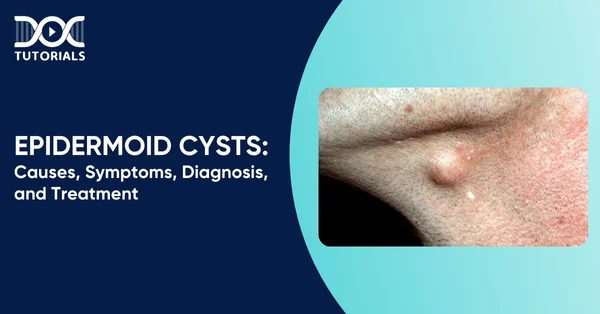Epidermoid Cyst | Causes, Symptoms, Diagnosis, and Treatment

An epidermoid cyst, also known as an epidermal inclusion cyst, is a type of cyst that grows under the skin. Arising from the epithelial cells lining the epidermis (upper layer of the skin), epidermoid cysts are usually non-cancerous.
Though the exact cause of this condition is yet to be known, some of the possible causes and signs are discussed to help you identify these cysts. Epidermoid cysts are an essential topic to study, especially if you’re preparing for the NEET PG exam.
Continue reading to learn more about epidermoid cysts, including their causes, symptoms, diagnosis, and treatment.
What are Epidermoid Cysts?
An epidermoid cyst is a painless, non-cancerous lump that develops under an individual’s skin. These are mostly found on the neck, head, back, or genitals in the form of benign lesions. Though they are mostly uncomplicated, malignancy may be present in rare cases.
The skin covering these cysts appears white or yellow, with keratin flakes filling the lumps. Epidermoid cysts do not cause pain, but they can be irritated due to inflammation.
Though these cysts are often referred to as pilar or sebaceous cysts, they have no involvement with the sebaceous gland. They usually develop within epidermal cysts, infundibular cysts, or epidermal inclusion cysts.
What are the Causes of Epidermoid Cysts?
Among the several layers of the skin, the thin, protective outer layer is called the epidermis. The cells of this skin layer slowly shed and get replaced with new cells as they move to the skin surface. In most cases, an epidermoid cyst develops when the epidermal cells (skin cells) become covered instead of shedding or moving under the surface of your skin.
Just like normal skin, these cells also multiply, secreting keratin (skin fluid) and forming a cyst (a wall around the cells). Keratin is a thick, yellow fluid that drains from the epidermoid cysts due to an injury.
Epidermoid cysts develop mainly around the cyst-like hair follicles that have openings. These openings transfer the lubricating oils needed for the hair. However, when these openings are blocked, and the skin area becomes inflamed, it leads to the formation of cysts. Damage to hair follicles due to a wound or scraping often causes this damage.
What are the Risk Factors of Epidermoid Cysts?
Though epidermoid cysts may affect anyone, here are some of the risk factors to be aware of:
- Individuals who have Gardner syndrome, a rare and inherited condition
- Individuals who are past the age of puberty
- Types of skin injury, etc.
What are the Symptoms of Epidermoid Cysts?
Here are some of the common symptoms of epidermoid cysts:
- Bad smell from the cyst
- You may feel a lump under the skin
- The colour of the cyst may turn red, or you may get inflammation
- Thick fluid may leak from the skin, etc.
Since the symptoms of epidermoid cysts resemble those of other skin conditions, the patient must consult a doctor for a diagnosis to confirm the same.
How to Diagnose Epidermoid Cysts?
Diagnosing an epidermoid cyst usually starts with a physical examination. A healthcare provider will inspect the lump, noting its size, shape, and whether it moves under the skin. Most epidermoid cysts are firm and round and have a central punctum, which helps distinguish them from other types of cysts.
If the diagnosis is uncertain, a small sample of the cyst or its contents may be taken for laboratory analysis. This helps confirm the diagnosis and rule out other conditions, such as infections or tumours. In rare cases, imaging tests such as ultrasound or CT (computed tomography) scans may be used, especially if the cyst is large or located in an unusual area.
Epidermoid cysts can look similar to sebaceous and pilar cysts, but they have different origins. Epidermoid cysts form from the outer skin layer (epidermis) or damaged hair follicles.
Sebaceous cysts, which are less common, come from sebaceous glands that produce skin oils. Pilar cysts develop from hair follicle roots and are most often found on the scalp. Accurate diagnosis ensures the proper treatment and helps avoid unnecessary procedures.
What are the Treatment Options for Epidermoid Cysts?
The following are some of the epidermoid cyst treatment methods:
- Observation
If the cyst is small, painless, and does not cause cosmetic concerns, it can often be ignored. Many people choose not to treat these cysts unless they become bothersome or painful.
- Steroid Injection
Injecting a corticosteroid directly into the cyst can help reduce swelling and inflammation, especially if the cyst is tender or inflamed. This method provides quick relief but does not eliminate the cyst itself, so recurrence is possible.
- Incision and Drainage
In this procedure, a healthcare provider makes a small cut in the cyst and gently squeezes out its contents. This approach provides fast symptom relief, particularly if the cyst is painful or infected. However, because the cyst wall remains, the cyst may return over time.
- Minor Surgery (Excision)
Surgical removal involves excising the entire cyst, including its wall and contents. This is the most effective way to prevent recurrence. The procedure is usually done under local anaesthesia, and stitches may be required. While this method is safe and has a high success rate, it can leave a scar.
If the cyst is inflamed, surgery may be postponed until the inflammation subsides. Each treatment option is selected based on the cyst’s size, symptoms, and the patient’s preference.
FAQs About Epidermoid Cysts
- What are the complications of epidermoid cysts?
Possible complications of epidermoid cysts include inflammation, making removal difficult; rupture, which can cause painful infection needing prompt care; and, very rarely, the development of skin cancer within the cyst.
- How to prevent epidermoid cysts?
You cannot prevent epidermoid cysts from forming, but you can lower the risk of scarring and infection by avoiding self-squeezing or popping the cyst and by applying a warm, moist cloth to help it drain and heal.
- What is the prognosis for epidermoid cysts?
Epidermoid cysts rarely cause long-term issues, but squeezing them can lead to infection, inflammation, and scarring. Cysts may return after draining, so consult your doctor if changes occur.
Conclusion
An epidermoid cyst is a crucial topic of the NEET PG syllabus. Aspirants must have a deeper understanding of this condition to ensure they are adequately prepared for their examination. In this regard, you can trust DocTutorials, a professional guide for a successful medical career.
Our NEET PG course is designed with detailed study materials, video lectures, timely assessment, etc., to ensure complete guidance for your exam. Join DocTutorials today and excel in your medical career!
Latest Blogs
-

NEET SS Exam 2024: Analysis, Key Dates, Counselling
The NEET SS 2024 exam kicked off on March 29, 2025. Over two days and two slots, candidates across 13…
-

NEET PG Registration 2025: An Essential Guide For Exam Prep
The NEET PG registration, which is conducted online, is a crucial step in the exam process. Filling out the NEET…
-

NEET PG Syllabus 2026: A Must-Have Complete Guide for Exam Success
The NEET PG Syllabus acts as one of the foundation stones for aspiring postgraduate medical students like you who are…




